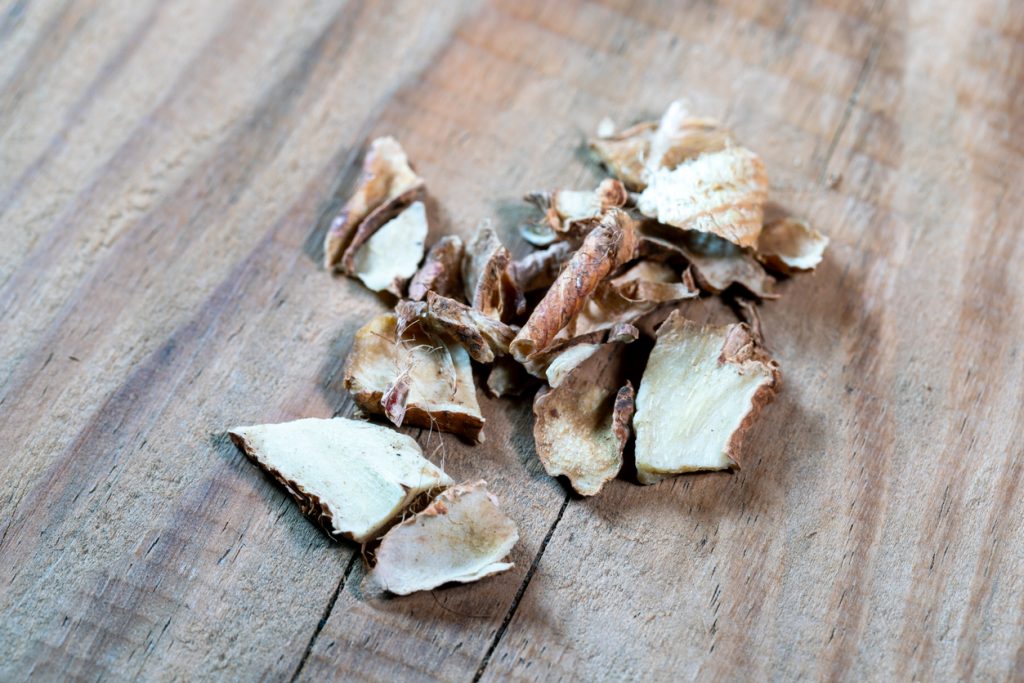Rhizoma Anemarrhenae (Zhi Mu)

What is Rhizoma Anemarrhenae (Zhi Mu)?
Rhizoma Anemarrhenae (zhi mu, 知母) is the rhizome of the perennial herbaceous plant Anemarrhena asphodeloides, which belongs to the family Liliaceae. The plant grows to a height of 0.5 m and a width of 1 m, and the thin leaves grow up to 70 cm long. The clusters of small, white to light-purple flowers are hermaphroditic (having both male and female organs) and blossom from August to September.
In Traditional Chinese Medicine (TCM), there are over 300 herbal formulas that use Rhizoma Anemarrhenae as an ingredient. It is one of the most commonly prescribed herbs in China, and is also used in a popular Korean formula to promote sleep and treat diabetes.
In Traditional Chinese Medicine (TCM), Rhizoma Anemarrhenae falls under the category of ‘Herbs that clear Heat and purge Fire and clear Summer Heat’. Such herbs are used to clear inflammatory and infectious conditions, referred to as ‘internal Heat’ in TCM. Hence, most herbs in this category will have both antibacterial and antiviral properties.
Cold in nature, Rhizoma Anemarrhenae can help individuals with too much Heat in their body, such as those experiencing a Yang Excess or a Yin Deficiency, to restore a harmonious yin-yang balance. Bitter and sweet in taste, Rhizoma Anemarrhenae can cleanse the body by clearing Heat, drying Dampness and promoting elimination via urination or bowel movements. Also, Rhizoma Anemarrhenae can help to slow down acute reactions and detoxify the body. It has a tonic effect on the body by replenishing qi and blood. In particular, Rhizoma Anemarrhenae targets the Kidneys, the Lungs and the stomach.
Functions and Benefits of Rhizoma Anemarrhenae (Zhi Mu)
Traditional Chinese Medicine (TCM) shows that Rhizoma Anemarrhenae has the following health benefits.
Rhizoma Anemarrhenae can clear Heat and purge Fire, especially excess Heat in the Lungs and stomach meridians. Hence, Rhizoma Anemarrhenae can address syndromes of Excess Heat in the qi system. For example, the herb can treat hyperactivity of pathogenic Heat manifested as lingering high fever, sweat, irritability and thirst. It can also help to manage stress caused by internal Heat or fire.
Rhizoma Anemarrhenae can clear Lung Heat and nourish Lung yin to remove Dryness from Lungs, and is thus indicated for cough caused by Lung Heat and dry cough caused by Yin Deficiency. For cough with sticky yellow sputum or dyspnea caused by the adverse flow of Lung qi due to accumulated Lung Heat, Rhizoma Anemarrhenae can be combined with other Heat-clearing and Phlegm-resolving herbs to stop cough and dyspnea.
As Rhizoma Anemarrhenae can clear stomach Fire and nourish stomach yin while generating fluids to quench thirst, it is indicated for stomach Heat syndrome manifested as thirst. The herb is also used to treat many health risks that young people face today, such as headache, swollen throat, painful and swollen gums caused by stomach Heat, constipation due to intestinal dryness, as well as prediabetes and diabetes.
In addition, Rhizoma Anemarrhenae can nourish Kidney yin and address Kidney Yin Deficiency. For example, the herb can address symptoms such as tidal fever, irritability, night sweat, and spermatorrhea.
The compound mangiferin, found in Rhizoma Anemarrhenae, has powerful anti-inflammatory and antioxidant properties that support the herb’s ability to improve memory and brain function, inhibit osteoporosis, and more. The compound is known to pass the blood-retina barrier, helping to treat a variety of eye disorders.

How to Use Rhizoma Anemarrhenae (Zhi Mu)
The recommended daily dosage of Rhizoma Anemarrhenae is 5 – 10g, when consumed as a decoction, powder or pill preparation. For nourishing yin and moistening, it is recommended to use Rhizoma Anemarrhenae in its dried form. To nourish Kidney yin and check virtual fire, it is recommended to process the herb by frying it with salt water.
Rhizoma Anemarrhenae and its supplements can be found in many herbal stores and Asian specialty markets.
Rhizoma Anemarrhenae is also often used in herbal formulas. For example, it is used in the herbal formula Zhi Bai Di Huang Wan (知柏地黄丸). This formula is used for Kidney yin and blood deficiency syndromes, such as breast cysts with hot flushes, warmth in chest and palm, night sweats, dry mouth, and lower back soreness.
Cautions and Side Effects of Rhizoma Anemarrhenae (Zhi Mu)
Rhizoma Anemarrhenae should not be used by individuals experiencing Spleen Deficiency with diarrhoea, impotence coupled with quick arousal and quick ejaculation, weak digestion, stomach deficiency with poor appetite, or Kidney Yang Deficiency.
Do use Rhizoma Anemarrhenae with caution in conjunction with other medications such as insulin and antidiabetic drugs.
We strongly encourage you to consult your healthcare provider before deciding to add Rhizoma Anemarrhenae to your healthcare routine!
Summary
Here is a summary for Rhizoma Anemarrhenae (Zhi Mu):
- Herb name (Chinese): 知母
- Herb name (Pin Yin): zhī mǔ
- Herb name (English): Common Anemarrhena Rhizome
- Herb name (Botanical): Rhizoma Anemarrhenae
- Origin of species: Anemarrhena asphodeloides Bge.
- Part(s) of herb used: Rhizome
- Geo-specific habitat(s): Hebei, Shanxi, Shandong
- Taste(s) & Properties: Bitter; Cold; Administrates the Lung, Stomach and Kidney Meridians
- Actions: Relieves constant thirst due to feverish or chronic conditions; Ideal for individuals who keep frequent late nights as well as those constantly under stressful conditions; Relieves coughs with little and thick yellow phlegm; Relieves symptoms of internal heat such as night sweating, restlessness or hot flushes; Eases constipation due to lack of fluids
References
Xiaonan, C. H. E. N., & Guowei, Z. H. A. N. G. (2014). Advances on Rhizoma anemarrhenae resistance to diabetes. Journal of Hebei Medical College for Continuing Education, 31(5), 85. [Accessed on 8th May 2023]
Xie, W., & Du, L. (2011). Diabetes is an inflammatory disease: evidence from traditional Chinese medicines. Diabetes, obesity and metabolism, 13(4), 289-301. [Accessed on 8th May 2023]
Share this article on
